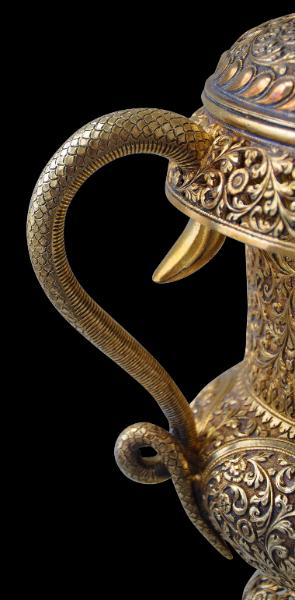
Cutch Kutch Colonial Indian Silver Trophy
Large Silver-Gilt Covered ‘Jubilee’ Presentation Cup with Handles
Kutch, India
before 1886
height: 44.5cm, width: 28cm, weight: 1,884g
This large and magnificent presentation cup and cover is almost unique in that it is entirely gilded. It was exhibited at the Colonial and Indian Exhibition, staged at South Kensington in London in 1886 (see an image below of the Cutch silver displayed at the Exhibition). The following year, it was presented to Lady Wynford by his Highness Khengarji III, the Maharao of Cutch, whilst the Maharao was in London for Queen Victoria’s Golden Jubilee. Victoria, by then, was also styled as Empress of India. The cup remained with the Wynford family until comparatively recently.
The cup is gilded (gold-plated) which is unusual for colonial Cutch silver. However, the gilding is appropriate for its purpose as an exhibition piece and then a presentation piece in association with Queen Victoria’s Golden Jubilee. The Maharao was among the fifty foreign kings and princes to attend the Jubilee State Dinner at Buckingham Palace on June 20, 1887 at which guests sat down to a buffet ‘covered with gold plate’ – the presence of which was no doubt in honor of the golden anniversary.
The cup is chased with Islamic-inspired floral and leaf scrolling that is typical of late nineteenth century colonial Indian silverwork from Cutch. It stands on a tiered, flared foot, has a baluster stem, and a pieced fringe. The bowl of the cup itself has a rim that is decorated with a pieced, everted fringe. Dramatic, elaborate snake-form handles to either side twist through this fringe. The lid is domed and rises to a multi-stage finial topped by a solid pointy bud.
The cup is surprisingly heavy in the hand – no silver has been spared in its construction.
The cup is entirely gilded (gold plated) inside as well as outside. The gilding to the interior is brighter than that on the outside, which usefully points to the gilding as being original. There is a very small armorial cartouche to one side of the pierced fringe to the rim.
The item is in excellent condition.
The Colonial and Indian Exhibition was organised largely by Albert, Prince of Wales, and staged in London to exhibit a broad range of aspects of Britain’s colonies with particular emphasis on colonial India which took about one third of the exhibition space. Exhibits included art, architecture, economic goods, silks and anthropological studies. The art items were organized by Indian provinces – which was a break from previous exhibitions where displays had been ordered by juries on their rankings. The India section was received well by the press and the Royal Family. The exhibition included a display of ‘native artisans’ – thirty-four men from Agra demonstrating various crafts and professions, from sweetmeat maker to potter to carpet weaver. They were all invited to a reception at Windsor Castle to meet Queen Victoria in July 1886. The exhibition was open for 164 days and welcomed 5,559,745 visitors.
Colonel G. R. Goodfellow served as Political Agent to the Maharao of Cutch in the 1880s and early 1890s, and accompanied the Maharao on his visit to London for Queen Victoria’s Golden Jubilee in 1887. The image below of the Cutch silver displayed at the Colonial and Indian Exhibition was kindly provided by a descendant of the Colonel Goodfellow. The photograph is inscribed in pencil with the words ‘Specimens of Cutch Silver work sent to Exhibition of 1886’ in what is believed to be Colonel Goodfellow’s handwriting. (Goodfellow also served as Political Resident in Aden.)
Overall, this is a superb piece of colonial Indian silverwork, and one that is also historically important.
References
Dehejia, V., Delight in Design: Indian Silver for the Raj, Mapin, 2008.
Terlinden, C., Mughal Silver Magnificence, Antalga, 1987.
Wilkinson, W.R.T, Indian Colonial Silver: European Silversmiths in India (1790-1860) and their Marks, Argent Press, 1973.
Provenance
2008-2012 – private collection, US;
Acquired in London in 2008;
Sold by the Wynford family at auction in 2005.
Given to Lady Wynford by his Highness the Maharao of Kutch, but thereafter handed down in the Wynford family of Dorset, UK.
Illustrated
Wilkinson, W., ‘Reflecting Power: Three Schools of Indian Silver’, 2008.
Inventory no.: 1862
SOLD

Khengarji III, the Maharao of Cutch

the Cutch silver of the 1886 exhibition, on the far right, top row.












